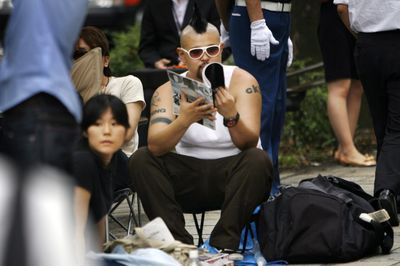Updated iPhone debuts today

TOKYO – Gadget lovers worldwide are already camped out ahead of today’s global rollout of the new model of Apple Inc.’s iPhone, which is also the first iPhone to go on sale in many countries.
Carrier Softbank Corp., which beat market leader NTT DoCoMo for the right to sell the iPhone in Japan, is planning a countdown ceremony at its flagship downtown store. By late Thursday, a line of nearly 800 iPhone fans snaked around the block, with some sleeping on the streets to ensure they would be among the first customers.
The iPhone goes on sale there five hours earlier than other nationwide outlets, helping to kick off a global rollout in 22 nations. The first model, which launched in the United States a year ago, ended up being sold only in six countries.
Because of time differences, the new iPhones are going on sale first in New Zealand, then Australia, followed by Japan and Hong Kong. In the United States, phones will be available at 8 a.m. in each time zone.
Japan, though, is the tech-mad market that analysts like to watch. It is home to powerful electronics brands such as Sony Corp. and Matsushita Electric Industrial Co.’s Panasonic, but its consumers are trend-chasers and have long adored Apple products such as the iPod.
Japan has about 107 million cell phones, or about one for every person. Many of the phones already work on 3G, or third-generation, wireless networks, offering the speedy Internet access that the new iPhone will also deliver. The old iPhone used a relatively slow cellular network combined with the ability to use fast Wi-Fi hotspots.
The iPhone’s capabilities are less revolutionary here, where people have for years used the tech-heavy local phones for restaurant searches, e-mail, music downloads, reading digital novels and electronic shopping. They tend to shrug off foreign models, such as those of Nokia Corp.
The latest Japanese cell phones have two key features absent on the iPhone – digital TV broadcast reception and the “electronic wallet” for making payments at stores and vending machines equipped with special electronic readers.
But they don’t have the iPhone’s nifty touch screen or glamour image.
Another key difference is that the iPhone is designed to browse the Web in the much the same way computers do. The networks promoted by Japanese carriers, such as “i-mode” from NTT DoCoMo, are more closed than the Web. Such systems have allowed carriers to control services and charge fees.
Norikazu Sasaki, a 20-year-old student among those in line for the iPhone in Tokyo, was already won over.
“The iPhone is so user-friendly, more than any other mobile phone. It combines the best features of a PC with the best features of a phone,” said Sasaki, who’s been taking turns with two friends to save his spot in the line since 1 a.m. Wednesday.
“There isn’t anything else like it,” Sasaki said.
The iPhone has sparked similar enthusiasm in Australia.
In downtown Sydney, Brett Howell, 36, didn’t mind fighting the chill of the Down Under winter for the distinction of being first in a line of about 40 at an Optus store Thursday.
“I wanted to make sure I got one,” he said as he huddled on the sidewalk with a small blanket and a book. “It’s only 11 hours in total.”
Ben Thomas, 27, had his own explanation for iPhone mania.
“It’s a chick magnet,” he said.